I guess it's the thing that people associate with electric guitars that they are durable, much tougher than acoustic guitars. And as such are much better suited to road life. But that's not always the case. Sometimes the very design of a guitar makes for weak points.
Such was the case with the Rickenbacker 300 series semi acoustics. Known for the light weight and sharp sound, the Rickenbacker 330 and deluxe model 360 were readily adopted by the bands from the British "Beat-boom" invasion in the mid sixties. And with Beatle members George Harrison and John Lennon playing Ricks and appearing in movies with those axes slung around, the mother lode opened up for Rickenbacker.

A beautiful sixties Rick 330/12 twelve string.
But because having the neck pickup right up against the end of the fingerboard, it meant that the neck itself was routed in a critical point to accommodate that pickup, resulting in a weak neck attachment. A player who found out how easy a Rickenbacker would break was of course Pete Townshend, at that famous picture of him and the wall with broken Rickenbackers, it's easy to spot the weak points of a Rickenbacker. One was the neck joint and the other was the headstock, to be precise: the routing where the truss rod nuts are.

Pete Townshend's hall of fame of smashed Rickenbackers, all of them have snapped headstocks and neck breaks.
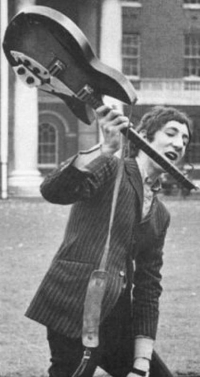
Pete Townshend in the process of smashing a Rickenbacker, the headstock has already snapped off.
One of the reasons that John Lennon switched to playing an Epiphone Casino was that all of his stage Rickenbackers suffered cracks at the point where the neck entered the body and at the headstock, just behind the nut. His surviving Rickenbackers still have the cracks visible.
About Lennon's surviving Ricks.
Rickenbacker addressed these issues and in the seventies their 300 series guitars came standard with a 24 fret neck with an improved truss rod system and a sturdier neck joint.
Say "Fragile" and Gibson is a brand that comes to mind, certainly their early sixties models Such as the SG, the Firebird and the Les Paul Special were guitars that needed to be treated very carefully.

A 1959 Les Paul Special double cutaway. As with Rickenbacker, the neck joint was routed at a critical point to accommodate the neck pickup. There wasn't really that much force needed to snap the neck right off. A later version of the Special had the neck pickup set further into the body regaining stability.
With the SG it's mostly the thinness of the body which did it, the neck tenon didn't have sufficient body material to be attached to. But another thing that really was a weak point for Gibson guitars was their headstocks. The angle in which the wood was spliced and glued back together again made for a very fragile headstock-neck joint.

A seventies SG with a snapped headstock
Gibson addressed this by adding a neck volute and changing the angle of the headstock joint but to no avail. These days, Gibson splices the wood further down the neck which creates a much stronger headstock-neck joint.
Still, you DON'T want to drop your Gibson, it'll break if you do...
And to close it all off, here's the Ibanez "Saber" series.

A 1991 Ibanez S540
A Page of the 1988 Ibanez Catalog describing the Saber series.
When conceived in 1987, the Saber was meant to be the ultimate shredding machine: providing players with a razor thin neck profile called "the wizard", a sleek tapered mahogany body, hot pickups and a Floyd Rose. The Saber was an instant hit and after 22 years is still going strong. Although current saber models have been altered somewhat because of problems that plagued the original Sabers.
"The Wizard" neck profile for example was prone to warping being so extremely thin. Current S-series guitars have the Wizard II which is a thicker neck. Also current day S-series guitars have laminated necks, to add more stability.
Another weak point of the S-series was the vibrato, because of having such a thin body, the studs sat at a very weak point in the body and many old S-series guitars suffered cracks where the studs sat. Currently Ibanez equips their S-series guitars with the so called "ZR tremolo" which is a Ball bearings design that's much sturdier, works much smoother and leaves no weak spots in the body.

The 2009 Ibanez S 470, an accumulation of Ibanez addressing almost everything that made the Saber series a breakable instrument.
Yup I said that ALMOST everything was addressed because the weakest spot of the Ibanez S-series still is the weakest spot.

The headstock of an early S-series guitar. The headstock of the S-series is spliced to the neck at a very steep angle, and to make matters worse, in order to attach the locking nut, they have to drill two holes to accommodate the bolts through the weakest spot of the neck. Despite making the necks thicker and making them using three pieces of maple or five pieces of maple and walnut, it doesn't work if you drill holes through the weakest point of the neck. The headstock will STILL snap off if you drop the guitar.
Such was the case with the Rickenbacker 300 series semi acoustics. Known for the light weight and sharp sound, the Rickenbacker 330 and deluxe model 360 were readily adopted by the bands from the British "Beat-boom" invasion in the mid sixties. And with Beatle members George Harrison and John Lennon playing Ricks and appearing in movies with those axes slung around, the mother lode opened up for Rickenbacker.

A beautiful sixties Rick 330/12 twelve string.
But because having the neck pickup right up against the end of the fingerboard, it meant that the neck itself was routed in a critical point to accommodate that pickup, resulting in a weak neck attachment. A player who found out how easy a Rickenbacker would break was of course Pete Townshend, at that famous picture of him and the wall with broken Rickenbackers, it's easy to spot the weak points of a Rickenbacker. One was the neck joint and the other was the headstock, to be precise: the routing where the truss rod nuts are.

Pete Townshend's hall of fame of smashed Rickenbackers, all of them have snapped headstocks and neck breaks.

Pete Townshend in the process of smashing a Rickenbacker, the headstock has already snapped off.
One of the reasons that John Lennon switched to playing an Epiphone Casino was that all of his stage Rickenbackers suffered cracks at the point where the neck entered the body and at the headstock, just behind the nut. His surviving Rickenbackers still have the cracks visible.
About Lennon's surviving Ricks.
Rickenbacker addressed these issues and in the seventies their 300 series guitars came standard with a 24 fret neck with an improved truss rod system and a sturdier neck joint.
Say "Fragile" and Gibson is a brand that comes to mind, certainly their early sixties models Such as the SG, the Firebird and the Les Paul Special were guitars that needed to be treated very carefully.

A 1959 Les Paul Special double cutaway. As with Rickenbacker, the neck joint was routed at a critical point to accommodate the neck pickup. There wasn't really that much force needed to snap the neck right off. A later version of the Special had the neck pickup set further into the body regaining stability.
With the SG it's mostly the thinness of the body which did it, the neck tenon didn't have sufficient body material to be attached to. But another thing that really was a weak point for Gibson guitars was their headstocks. The angle in which the wood was spliced and glued back together again made for a very fragile headstock-neck joint.

A seventies SG with a snapped headstock
Gibson addressed this by adding a neck volute and changing the angle of the headstock joint but to no avail. These days, Gibson splices the wood further down the neck which creates a much stronger headstock-neck joint.
Still, you DON'T want to drop your Gibson, it'll break if you do...
And to close it all off, here's the Ibanez "Saber" series.

A 1991 Ibanez S540
A Page of the 1988 Ibanez Catalog describing the Saber series.
When conceived in 1987, the Saber was meant to be the ultimate shredding machine: providing players with a razor thin neck profile called "the wizard", a sleek tapered mahogany body, hot pickups and a Floyd Rose. The Saber was an instant hit and after 22 years is still going strong. Although current saber models have been altered somewhat because of problems that plagued the original Sabers.
"The Wizard" neck profile for example was prone to warping being so extremely thin. Current S-series guitars have the Wizard II which is a thicker neck. Also current day S-series guitars have laminated necks, to add more stability.
Another weak point of the S-series was the vibrato, because of having such a thin body, the studs sat at a very weak point in the body and many old S-series guitars suffered cracks where the studs sat. Currently Ibanez equips their S-series guitars with the so called "ZR tremolo" which is a Ball bearings design that's much sturdier, works much smoother and leaves no weak spots in the body.

The 2009 Ibanez S 470, an accumulation of Ibanez addressing almost everything that made the Saber series a breakable instrument.
Yup I said that ALMOST everything was addressed because the weakest spot of the Ibanez S-series still is the weakest spot.

The headstock of an early S-series guitar. The headstock of the S-series is spliced to the neck at a very steep angle, and to make matters worse, in order to attach the locking nut, they have to drill two holes to accommodate the bolts through the weakest spot of the neck. Despite making the necks thicker and making them using three pieces of maple or five pieces of maple and walnut, it doesn't work if you drill holes through the weakest point of the neck. The headstock will STILL snap off if you drop the guitar.
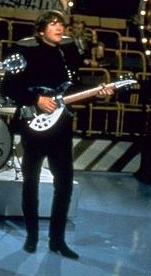



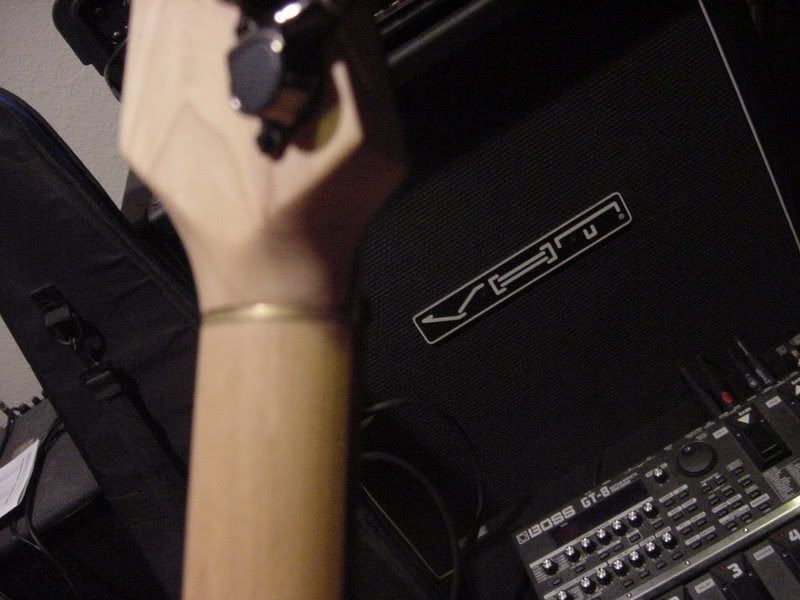

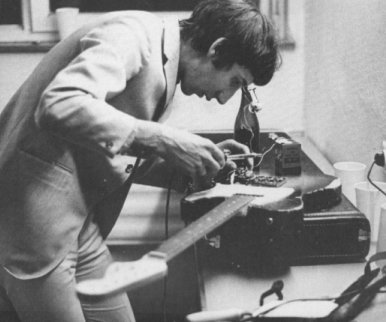
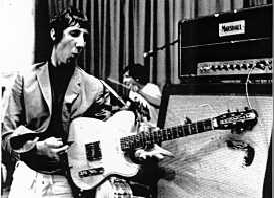
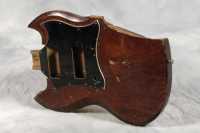
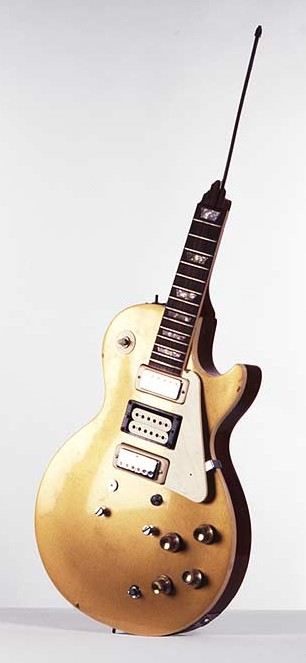
Comment